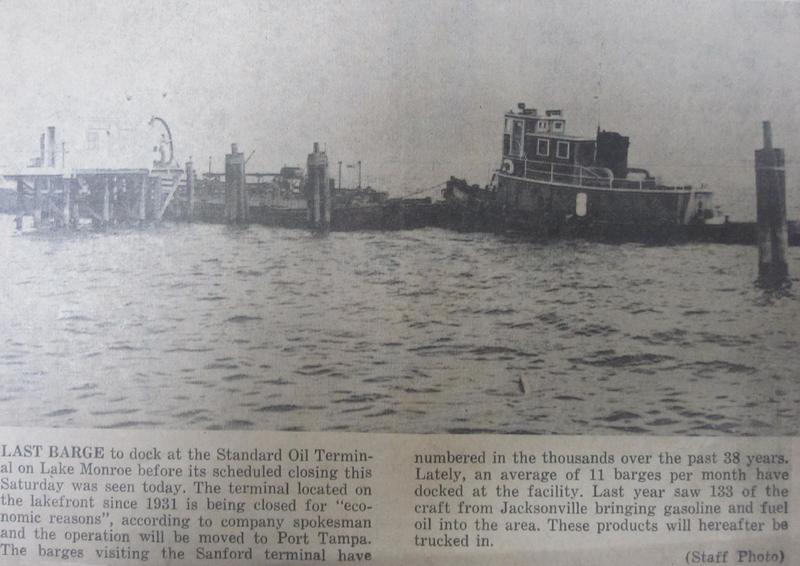Last Barge to Dock at the Standard Oil Terminal on Lake Monroe Before Its Scheduled Closing This Saturday was Seen Today
Dublin Core
Title
Last Barge to Dock at the Standard Oil Terminal on Lake Monroe Before Its Scheduled Closing This Saturday was Seen Today
Alternative Title
Last Barge to Dock at the Standard Oil Terminal
Subject
Waterfront Districts
Barges
Lakes & ponds
Lake Monroe (Seminole County and Volusia County, Fla.)
Standard Oil Company
Oil industry
Energy industry
Description
Newspaper article about the last barge docked on the Standard Oil Terminal along Lake Monroe in Sanford, Florida. The terminal opened in 1931 and closed in 1969.
The present-day Sanford, Florida, area was originally inhabited by the Mayaca and Joroco tribes by the time Europeans arrived. The tribe was decimated by war and disease by 1760 and was replaced by the Seminole tribe.
In 1821, the United States acquired Florida from Spain and Americans began to settled in the state. Camp Monroe was established in the mid-1830s to defend the area against Seminoles during the Seminole Wars. Following an attack on February 8, 1837, the camp was renamed Fort Mellon in honor of the battle's only American casualty, Captain Charles Mellon. The Town of Mellonville was founded nearby in 1842 by Daniel Stewart. When Florida became a state three years later, Mellonville became the county seat for Orange County, which was originally a portion of Mosquito County. Citrus was the first cash crop in the area and the first fruit packing plant was constructed in 1869.
In 1870, Henry Shelton Sanford purchased over 12,000 acres of land west of Mellonville to form the community of Sanford. which he called "The Gateway City to South Florida." Sanford was incorporated in 1877 and absorbed Mellonville in 1883. The Great Fire of 1887 devastated the city, which also suffered from a statewide epidemic of yellow fever the following year. The citrus industry flourished until the Great Freezes of 1894 and 1895, causing planters to begin growing celery in 1896 as an alternative. Celery replaced citrus as the city's cash crop and Sanford was nicknamed "The Celery City." In 1913, Sanford became the county seat of Seminole County, once part of Orange County. Agriculture dominated the region until Walt Disney World opened in October of 1971, effectively shifting the Central Florida economy towards tourism and residential development. In 2003, Sanford began the redevelopment of the waterfront with the RiverWalk Project to revitalize the city's riverfront.
The present-day Sanford, Florida, area was originally inhabited by the Mayaca and Joroco tribes by the time Europeans arrived. The tribe was decimated by war and disease by 1760 and was replaced by the Seminole tribe.
In 1821, the United States acquired Florida from Spain and Americans began to settled in the state. Camp Monroe was established in the mid-1830s to defend the area against Seminoles during the Seminole Wars. Following an attack on February 8, 1837, the camp was renamed Fort Mellon in honor of the battle's only American casualty, Captain Charles Mellon. The Town of Mellonville was founded nearby in 1842 by Daniel Stewart. When Florida became a state three years later, Mellonville became the county seat for Orange County, which was originally a portion of Mosquito County. Citrus was the first cash crop in the area and the first fruit packing plant was constructed in 1869.
In 1870, Henry Shelton Sanford purchased over 12,000 acres of land west of Mellonville to form the community of Sanford. which he called "The Gateway City to South Florida." Sanford was incorporated in 1877 and absorbed Mellonville in 1883. The Great Fire of 1887 devastated the city, which also suffered from a statewide epidemic of yellow fever the following year. The citrus industry flourished until the Great Freezes of 1894 and 1895, causing planters to begin growing celery in 1896 as an alternative. Celery replaced citrus as the city's cash crop and Sanford was nicknamed "The Celery City." In 1913, Sanford became the county seat of Seminole County, once part of Orange County. Agriculture dominated the region until Walt Disney World opened in October of 1971, effectively shifting the Central Florida economy towards tourism and residential development. In 2003, Sanford began the redevelopment of the waterfront with the RiverWalk Project to revitalize the city's riverfront.
Source
Original newspaper article, May 28, 1969.
Date Created
ca. 1969-05-28
Date Copyrighted
1969-05-28
Has Format
Original newspaper article, May 28, 1969: Cities/Towns-Sanford Collection, Orange County Regional History Center, Orlando, Florida.
Is Format Of
Digital reproduction of original newspaper article, May 28, 1969.
Format
image/jpg
Extent
1.13 MB
Medium
1 newspaper article
Language
eng
Type
Document
Coverage
Sanford, Florida
Accrual Method
Donation
Mediator
History Teacher
Economics Teacher
Geography Teacher
Rights Holder
Copyright to this resource is held by the Orange County Regional History Center and is provided here by RICHES of Central Florida for educational purposes only.
Curator
Cepero, Laura
Digital Collection
Source Repository
External Reference
Sanford Historical Society (Fla.). Sanford. Charleston, SC: Arcadia, 2003.
The Seminole Herald. Sanford: Our First 125 Years. [Sanford, FL]: The Herald, 2002.
"Sanford: A Brief History." City of Sanford. http://www.sanfordfl.gov/index.aspx?page=48.
Transcript
LAST BARGE to dock at the Standard Oil Terminal on Lake Monroe before its scheduled closing this Saturday was seen today. The terminal located on the lakefront since 1931 is being closed for "economic reasons", according to company spokesman and the operation will be moved to Port Tampa. The barges visiting the Sanford terminal have numbered in the thousands over the past 38 years. Lately, an average of 11 barges per month have docked at the facility. Last year saw 133 of the craft from Jacksonville bringing gasoline and fuel oil into the area. these products will hereafter be trucked in.
(Staff Photo)
(Staff Photo)
Still Image Item Type Metadata
Original Format
1 newspaper article
Collection
Citation
“Last Barge to Dock at the Standard Oil Terminal on Lake Monroe Before Its Scheduled Closing This Saturday was Seen Today,” RICHES, accessed December 11, 2025, https://richesmi.cah.ucf.edu/omeka/items/show/2189.
